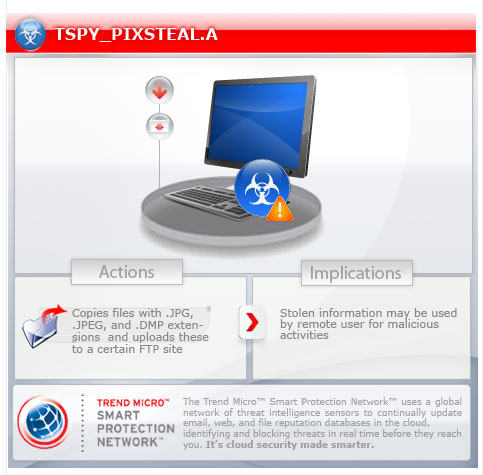TSPY_PIXSTEAL.A
BDS/Wasew.A (Antivir)
Windows 2000, Windows XP, Windows Server 2003


Threat Type: Spyware
Destructiveness: No
Encrypted:
In the wild: Yes
OVERVIEW
Dropped by other malware, Downloaded from the Internet
This malware copies .JPG, .JPEG, and .DMP files and sends these to a remote FTP server.
To get a one-glance comprehensive view of the behavior of this Spyware, refer to the Threat Diagram shown below.

For the related story, you may read the blog post Malware Steals Image Files from Systems.
This spyware arrives on a system as a file dropped by other malware or as a file downloaded unknowingly by users when visiting malicious sites.
TECHNICAL DETAILS
237,630 bytes
EXE
No
27 Apr 2013
Connects to URLs/IPs
Arrival Details
This spyware arrives on a system as a file dropped by other malware or as a file downloaded unknowingly by users when visiting malicious sites.
Other System Modifications
This spyware adds the following registry entries:
HKEY_LOCAL_MACHINE\SYSTEM\CurrentControlSet\
Services\SharedAccess\Parameters\
FirewallPolicy\StandardProfile\AuthorizedApplications\
List
{malware path and filename} = "{malware path and filename}:*:Enabled:{Port}"
Drop Points
This spyware uploads files to the following File Transfer Protocol (FTP) sites:
- ftp://{BLOCKED}.{BLOCKED}.208.90
NOTES:
It copies all files with .JPG, .JPEG, and .DMP extensions from C:\ , D:\, and E:\ directories to C:\.
It uploads all files located in the C:\ directory to the defined FTP site using certain credentials.
SOLUTION
9.300
9.498.05
31 Oct 2012
9.499.00
31 Oct 2012
Step 1
Before doing any scans, Windows XP, Windows Vista, and Windows 7 users must disable System Restore to allow full scanning of their computers.
Step 2
Delete this registry value
Important: Editing the Windows Registry incorrectly can lead to irreversible system malfunction. Please do this step only if you know how or you can ask assistance from your system administrator. Else, check this Microsoft article first before modifying your computer's registry.
- In HKEY_LOCAL_MACHINE\SYSTEM\CurrentControlSet\Services\SharedAccess\Parameters\FirewallPolicy\StandardProfile\AuthorizedApplications\List
- "{malware path and filename}" = "{malware path and filename}:*:Enabled:{Port}"
- "{malware path and filename}" = "{malware path and filename}:*:Enabled:{Port}"
Step 3
Scan your computer with your Trend Micro product to delete files detected as TSPY_PIXSTEAL.A If the detected files have already been cleaned, deleted, or quarantined by your Trend Micro product, no further step is required. You may opt to simply delete the quarantined files. Please check this Knowledge Base page for more information.
Did this description help? Tell us how we did.


